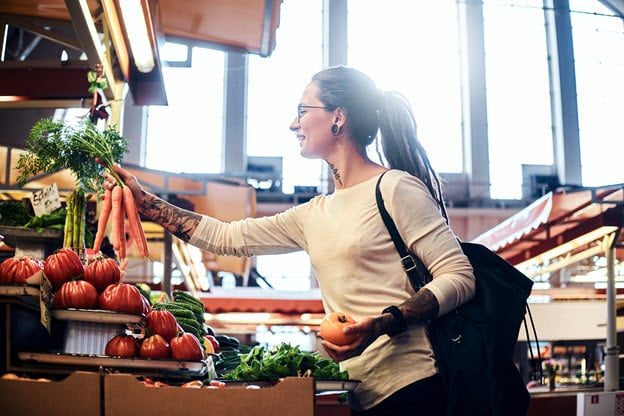Sharing is Caring!
When we buy groceries, do we think about sustainable shopping and the environmental impact of what we buy? For the past few years, I’ve tried to do that every time I buy groceries, and I’ve also considered how I’m going to recycle each item made of plastic, glass, or paper.
Furthermore, every item in your grocery cart has an environmental footprint. From the fields where crops are grown to the packaging that brings products to your kitchen, each stage of the supply chain contributes to greenhouse gas emissions, water use, and waste. Therefore, small choices at the store can add up to meaningful changes for the planet.
Sustainable Shopping: Food Production and Resource Use
Agriculture is a significant source of environmental impact.
Did you know that meat and dairy products require significantly more water and energy than plant-based foods? Cattle produce methane, a potent greenhouse gas, while industrial crop production can deplete soil and water supplies.
Furthermore, seasonal and local produce reduces the need for long-distance transportation and heavy refrigeration. More importantly, this lowers carbon emissions and energy consumption.
While I’ve decreased the amount of beef I eat and purchase, I feel this contributes to sustainable shopping habits and helps the environment. I’ve also checked plastics and paper containers to ensure I can recycle them efficiently.
Packaging and Waste
Packaging plays an essential role in food safety, but can also increase environmental strain.
For example, single-use plastics, non-recyclable containers, and excessive wrapping contribute to landfill waste and pollution. Choosing products with minimal or recyclable packaging helps reduce this burden.
Advances in technology, such as sustainable cold chain packaging, enable perishable items to remain fresh while minimizing energy consumption and reducing environmental impact. These solutions combine food safety with eco-conscious design and show that sustainability and practicality can coexist.
While these advances help us engage in sustainable shopping, it’s always a good idea to reach out to our friends and family to ensure they are doing the same.
Transportation and Carbon Footprint
Here’s one many of us don’t think about. The distance food travels before it reaches your kitchen is another factor.
Imported or out-of-season products often require refrigeration and long transport, which increases fuel use and emissions.
Even within a country, heavy trucking for groceries can contribute significantly to carbon output and road congestion. Buying locally grown or regionally sourced items reduces transportation-related energy demands, lowers emissions, and supports nearby farmers and local economies.
In addition to the above, I always try to shop locally and support my local farmers and businesses. Plus, in doing so, you can enjoy the benefits of fresh fruits and vegetables and local cattle suppliers. I love shopping for fresh eggs locally produced from shops I know and trust in my area.
Sustainable Shopping: Reducing Waste at Home
Food waste is one of the most significant contributors to household environmental impact.
When we throw away uneaten food, the resources used to produce, package, and transport it all go to waste.
When I have food that’s expired or uneaten, I always give it to my local animals in my backyard so they can reap the benefits, and they love it! I also save money as I don’t have to buy feed for them.
Additionally, planning meals, storing items properly, and composting scraps can help minimize waste. Small actions, like using reusable shopping bags and containers, separating recyclables, freezing leftovers, and repurposing ingredients, further reduce the environmental footprint of daily grocery routines and conserve valuable resources.
When I shop, I always take my reusable shopping bags with me to save on plastic bags. When I have plastic bags, I always make sure to reuse them a few times before recycling them.
Always remember this: your grocery choices ripple outward, influencing energy use, waste, and emissions.
Thoughtful decisions about what you buy, how it is packaged, and how it is stored can lower your personal environmental impact.
Paying attention to sustainable shopping practices makes every trip to the store a step toward a healthier planet. For more information, look over the accompanying resource below.
Sharing is Caring!
Disclaimer: This story is auto-aggregated by a computer program and has not been created or edited by jennertrends.
Publisher: Source link













